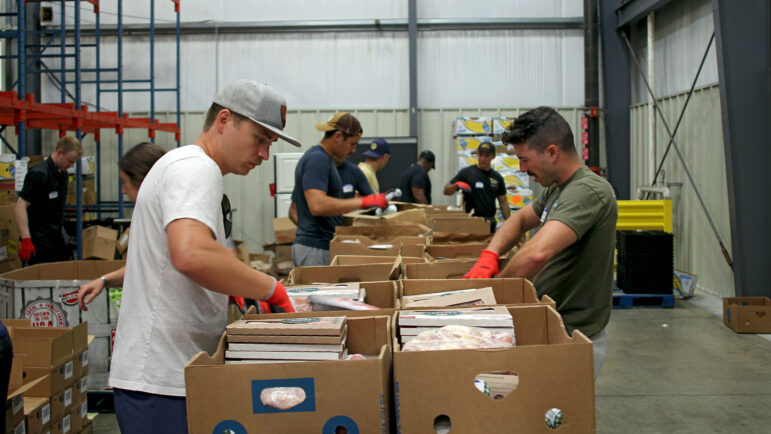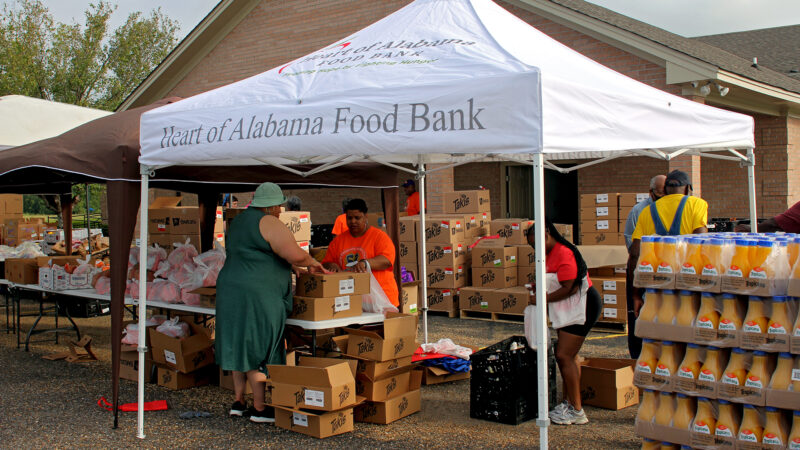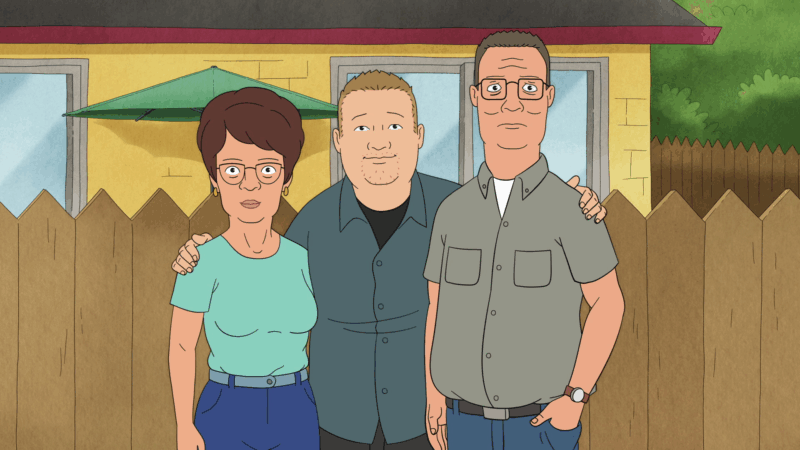How Alabama food banks are keeping rural communities fed
Volunteers help patrons of Shiloh Primitive Baptist Church’s mobile food pantry in Lowndesboro, Alabama, on Aug 22. 2024. Although Shiloh isn’t in District 2, the county deals with similar issues, like poverty, as other communities in South Central Alabama.
Nearly 20 cars line the street outside of Shiloh Primitive Baptist Church in Lowndesboro, Alabama, in late August. Volunteers have placed laminated numbers onto their dashboards to count how many families will be served when the cars start their journey through the line.
It’s the first time this church has done a mobile food pantry, coordinated by the Alabama Office of Minority Affairs and Heart of Alabama Food Bank. An 18-wheeler has unloaded dozens of pallets of boxed foods — fresh lettuce and apples, potato chips, orange juice and more.
Residents like Viola Loving call it a blessing.
“They’re a godsend for people that don’t have anything,” Loving said.
Loving is homeless and has been living in her truck for almost a year now. She’s on social security income, which she said isn’t enough to cover living expenses — such as rent and food. A few weeks before coming to the mobile pantry, she spent $800 on maintenance work for her car. It wasn’t enough to fix it, but enough to keep her moving.

“I couldn’t afford it,” she said. “It’s another $400. I couldn’t do it. That’s a bite.”
Loving came to Shiloh to pick up boxes of shelf-stable food to keep in her car while she tries to manage her health and find an affordable place to live. She said that sometimes she relies on the kindness of restaurants to stay fed — sometimes receiving a sandwich, or fries and a drink.
“Most of the time, they say ‘We can’t do that. We can’t afford to give you anything. That comes out of our pockets,’” she said.
Amy Dennis, community engagement coordinator for Heart of Alabama Food Bank, said their mission is to keep as many families fed as possible. Between partner pantries and affiliates, Heart of Alabama Food Bank covers 35 counties, distributing about 30 million pounds of food each year to South Central Alabama. The organization holds mobile food pantries across the region nearly every day of the week, with dozens of volunteers and staff at the warehouse also packaging food for school backpack programs, senior citizens and veterans.
“Sometimes ends just don’t meet, even for people that have worked very hard,” Dennis said. “Food banks and the programs that we operate like this one support people that have fallen in between.”

Food insecurity affects nearly 1 in 5 adults, and 1 in 4 children in Alabama, according to the Alabama Department of Public Health. It’s a demand that can wear on some smaller pantries, especially as they seek more funding to survive. Dennis said local pantries have volunteers who are eager to help, but the food bank can buy more items at lower prices.
“At the end of the day, sometimes those dollars make the biggest difference,” she said. “[Partner pantries] tell us time and time again, ‘The reason we’re not serving more people is because we don’t have the money to purchase more food.”
But it’s not just a matter of getting the food to families. It’s getting families to where they can receive help. Carol Gundlach, a senior policy analyst with Alabama Arise, said having reliable transportation is key in steadily growing food deserts.
“There are very few grocery stores,” Gundlach said. “If you don’t have transportation, it’s very difficult to get to a grocery store, to get to Montgomery, to get to Opelika, to get to wherever there are big grocery stores or Walmarts.”
Issues of poverty often pile up, Gundlach said, and families can quickly find themselves deciding which living expense to prioritize. Recently, Pandemic SNAP benefits ended, meaning families lost extra supplemental funds for groceries, which sometimes put them in more difficult positions than before.
“There’s a whole food inflation going on at the same time that SNAP benefits have declined,” she said, which could lead to an increase of residents needing more resources — making it difficult for rural pantries to keep up.
“What demand there is, gets dumped more and more on the private nonprofit sector like the little food pantries that are run by churches,” she said. “It’s a valiant effort, but they cannot meet the need.”
Gundlach said federal funding could greatly improve poverty in South Alabama. With the November elections drawing close, residents in District 2 — where congressional lines were redrawn last year — have a big decision to make.
“I hope that District 2 makes a good decision when they vote because we really desperately need resources,” Gundlach said. “Not just here, but all across the Black Belt.”
This story was produced by the Gulf States Newsroom, a collaboration between Mississippi Public Broadcasting, WBHM in Alabama, WWNO and WRKF in Louisiana and NPR.
How Trump’s travel ban could disrupt the way knowledge about health is shared
Global health specialists talk about the consequences of the full or partial ban on travel to the U.S. from 19 countries.
Trump threatens Iran’s supreme leader, escalating his rhetoric about the conflict
President Trump called Iran's Supreme Leader Ayatollah Ali Khamenei an "easy target" but said, "We are not going to take him out (kill!), at least not for now."
With the World Cup a year away, the U.S. men’s soccer team needs a shot in the arm
A handful of dreadful losses — plus some drama between the team's biggest star and its new head coach — has the USMNT looking for a badly-needed rebound in this summer's Gold Cup tournament.
Joey Chestnut will return to the Coney Island hot dog contest after last year’s beef
Joey Chestnut was banned from the contest that made him famous after signing an endorsement deal with a company that makes plant-based proteins. The 16-time champ returns to Coney Island on July 4th.
New books out this week offer catastrophes that at least profess to be just fantasies
The new books publishing this week may get quite heavy, laden as they are with family tragedy, psychopathy and heartbreak — but at least they are fiction.
The summer TV season is almost here. Here’s what to watch.
Here are some of the best summer TV shows — from Marvel reviving its fortunes with a new armored hero to TV's most compelling serial killer returning for a bite of the Big Apple.









